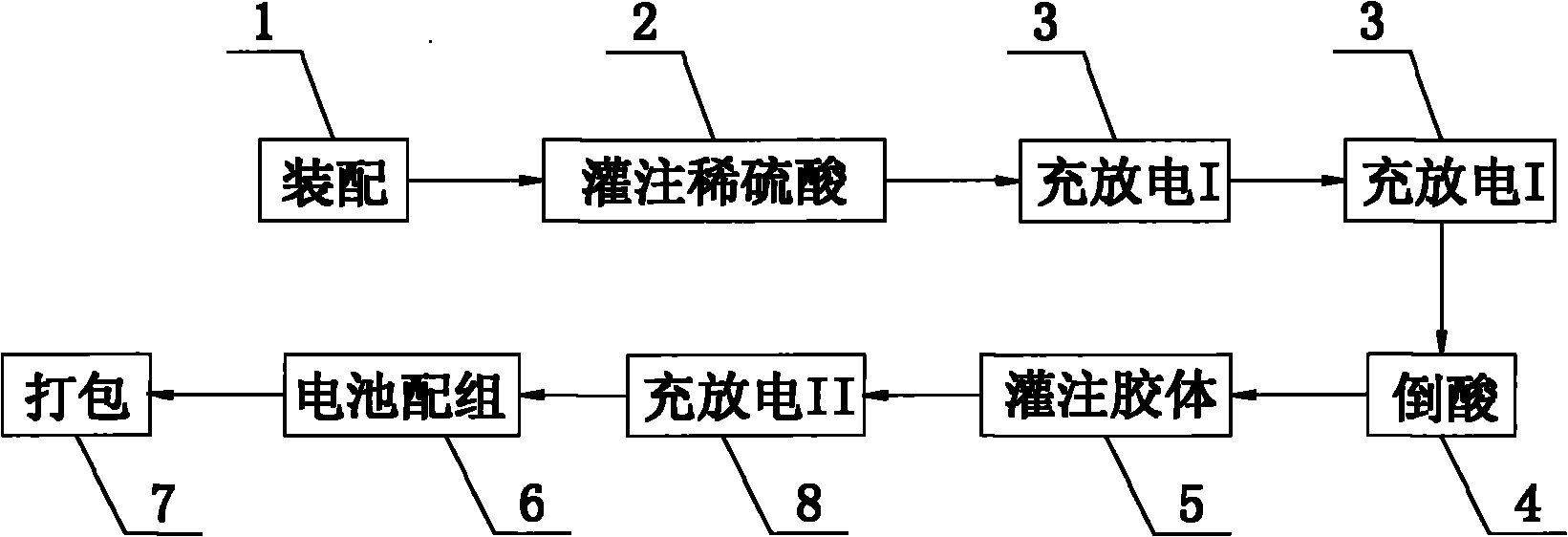Internal formation process for high-capacity gel battery
A colloidal battery, internalization technology, applied in the direction of lead-acid battery, lead-acid battery construction, sustainable manufacturing/processing, etc., can solve the problems of short life, poor battery consistency, etc., to prolong service life, improve consistency, reduce Effect of waste acid discharge
- Summary
- Abstract
- Description
- Claims
- Application Information
AI Technical Summary
Problems solved by technology
Method used
Image
Examples
Embodiment 1
[0023] An internal formation process for a large-capacity colloidal battery, comprising the following steps in sequence:
[0024] A. Assembly 1: The polar plates after curing and drying are first assembled according to the weight, and the polar plates and separators are welded into a pole group through a special tooling fixture, put into a plastic case, and assembled into a non-liquid-injected Rechargeable Battery;
[0025] B. Infusion of dilute sulfuric acid 2: use concentrated sulfuric acid and water to prepare a density of 1.240g / cm 3 dilute sulfuric acid, then add 1% by weight sodium sulfate, 0.5% potassium sulfate, and 0.4% stannous sulfate, and pour it into the storage battery by vacuum injection;
[0026] C. Charge and discharge Ⅰ 3: charge and discharge twice, in the last discharge process, discharge the battery capacity to 105% of the rated capacity, and the discharge termination voltage is 9.60V ~ 10.50V;
[0027] D. Pour acid 4: Pour out excess acid;
[0028] E. ...
Embodiment 2
[0033] An internal formation process for a large-capacity colloidal battery, comprising the following steps in sequence:
[0034] A. Assembly 1: The polar plates after curing and drying are first assembled according to the weight, and the polar plates and separators are welded into a pole group through a special tooling fixture, put into a plastic case, and assembled into a non-liquid-injected Rechargeable Battery;
[0035] B. Infusion of dilute sulfuric acid 2: use concentrated sulfuric acid and water to prepare a density of 1.240g / cm 3 dilute sulfuric acid, then add 1.25% sodium sulfate, 0.1% potassium sulfate, and 0.6% stannous sulfate to it, and pour it into the storage battery by vacuum injection;
[0036] C. Charge and discharge 3: charge and discharge twice, in the last discharge process, discharge the battery capacity to 105% of the rated capacity, and the discharge termination voltage is 9.60V ~ 10.50V;
[0037] D. Pour acid 4: Pour out excess acid;
[0038] E. Per...
Embodiment 3
[0043] An internal formation process for a large-capacity colloidal battery, comprising the following steps in sequence:
[0044] A. Assembly 1: The polar plates after curing and drying are first assembled according to the weight, and the polar plates and separators are welded into a pole group through a special tooling fixture, put into a plastic case, and assembled into a non-liquid-injected Rechargeable Battery;
[0045] B. Infusion of dilute sulfuric acid 2: use concentrated sulfuric acid and water to prepare a density of 1.240g / cm 3 dilute sulfuric acid, then add 11.5% by weight sodium sulfate, 0.3% potassium sulfate, 0.2% stannous sulfate, and pour it into the storage battery by vacuum injection;
[0046] C. Charge and discharge 3: charge and discharge twice, in the last discharge process, discharge the battery capacity to 105% of the rated capacity, and the discharge termination voltage is 9.60V ~ 10.50V;
[0047] D. Pour acid 4: Pour out excess acid;
[0048] E. Per...
PUM
| Property | Measurement | Unit |
|---|---|---|
| density | aaaaa | aaaaa |
Abstract
Description
Claims
Application Information
 Login to View More
Login to View More - R&D
- Intellectual Property
- Life Sciences
- Materials
- Tech Scout
- Unparalleled Data Quality
- Higher Quality Content
- 60% Fewer Hallucinations
Browse by: Latest US Patents, China's latest patents, Technical Efficacy Thesaurus, Application Domain, Technology Topic, Popular Technical Reports.
© 2025 PatSnap. All rights reserved.Legal|Privacy policy|Modern Slavery Act Transparency Statement|Sitemap|About US| Contact US: help@patsnap.com



